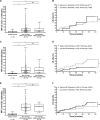Molecular and serologic markers of HPV 16 infection are associated with local recurrence in patients with oral cavity squamous cell carcinoma
- PMID: 28422732
- PMCID: PMC5471014
- DOI: 10.18632/oncotarget.16747
Molecular and serologic markers of HPV 16 infection are associated with local recurrence in patients with oral cavity squamous cell carcinoma
Abstract
Human papillomavirus (HPV) infections predict mortality in Taiwanese patients with oral cavity squamous cell carcinoma (OCSCC). To address their prognostic significance for local recurrence (LR), in this retrospective cohort study we investigated different serologic and molecular markers of HPV 16 infection in 85 consecutive patients with primary OCSCC who received standard treatment and had their sera stored before treatment. Resected tumor specimens were examined with PCR-based assays for HPV 16 E6/E7 mRNA expression. Sera were tested with suspension arrays for the presence of HPV-specific antibodies using synthetic L1 and E6 peptides as well as a synthetic E7 protein. HPV 16 E6/E7 mRNA, anti-L1, anti-E6, and anti-E7 antibodies tested positive in 12%, 25%, 38%, and 41% of the study patients, respectively. Multivariate analysis identified pathological T3/T4, E6/E7 mRNA, and anti-E7 antibodies as independent risk factors for LR, whereas anti-E6 antibodies were an independent protective factor. In patients with ≥ 3 (high-risk group), 2 (intermediate-risk), and ≤ 1 (low-risk) independent risk factors (predictors), the 5-year LR rates were 75%, 42%, and 4%, respectively. Results were validated in an independent cohort. Together, our preliminary data indicate that HPV 16 infections as well as low and high serum levels of anti-E6 and anti-E7 antibodies, respectively, can serve as biomarkers of LR in patients with OCSCC, whereas the clinical usefulness of anti-HPV 16 antibodies for risk stratification of newly diagnosed cases deserves further scrutiny.
Keywords: human papillomavirus; local recurrence; mRNA expression; oral cavity squamous cell carcinoma; serology.
Conflict of interest statement
No potential conflicts of interest exist.
Figures



References
-
- Chiang CJ, Lo WC, Yang YW, You SL, Chen CJ, Lai MS. Incidence and survival of adult cancer patients in Taiwan, 2002–2012. J Formos Med Assoc. 2016;115:1076–1088. - PubMed
-
- Shaikh MH, McMillan NA, Johnson NW. HPV-associated head and neck cancers in the Asia Pacific: A critical literature review & meta-analysis. Cancer Epidemiol. 2015;39:923–938. - PubMed
-
- Lee LA, Huang CG, Tsao KC, Liao CT, Kang CJ, Chang KP, Huang SF, Chen IH, Fang TJ, Li HY, Yang SL, Lee LY, Hsueh C, et al. Human papillomavirus infections are common and predict mortality in a retrospective cohort study of Taiwanese patients with oral cavity cancer. Medicine (Baltimore) 2015;94:e2069. - PMC - PubMed
MeSH terms
Substances
LinkOut - more resources
Full Text Sources
Other Literature Sources
Medical

